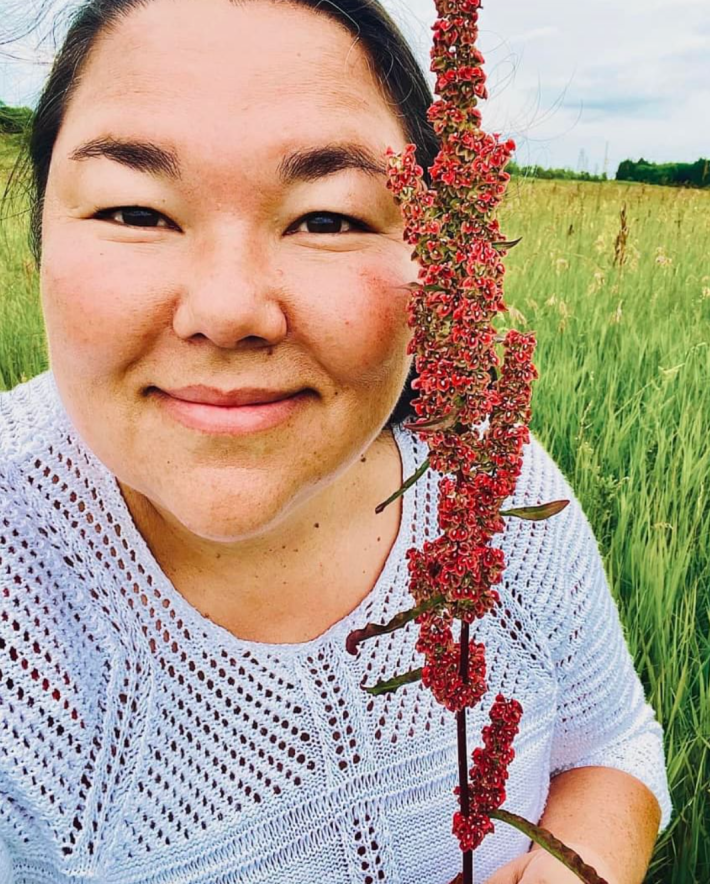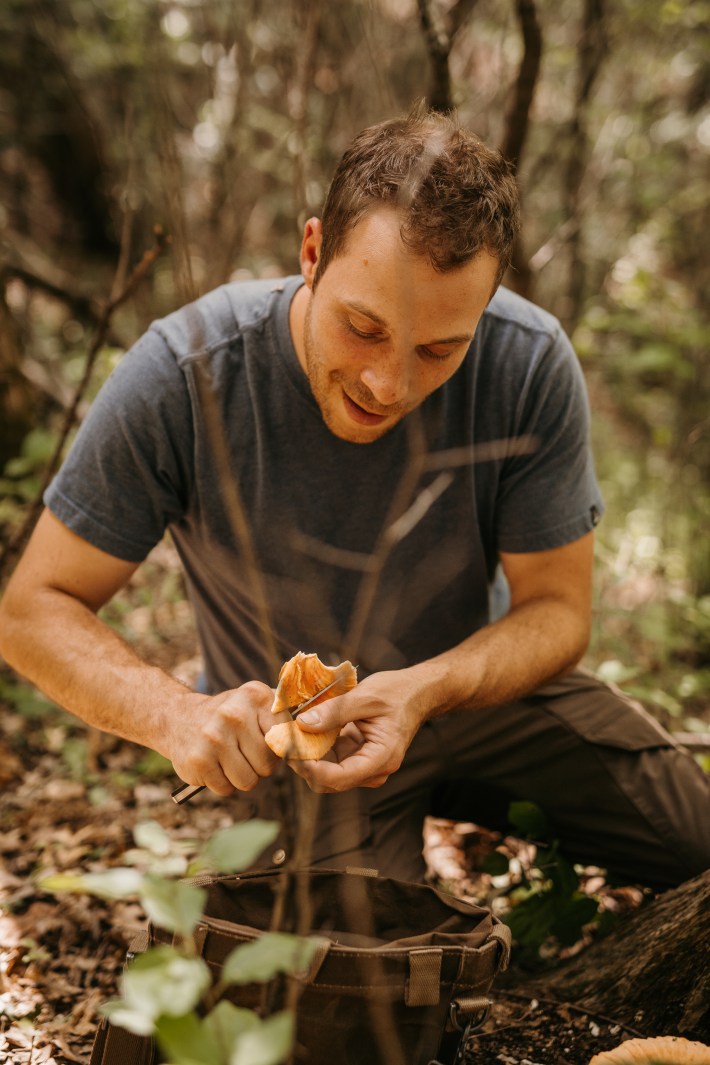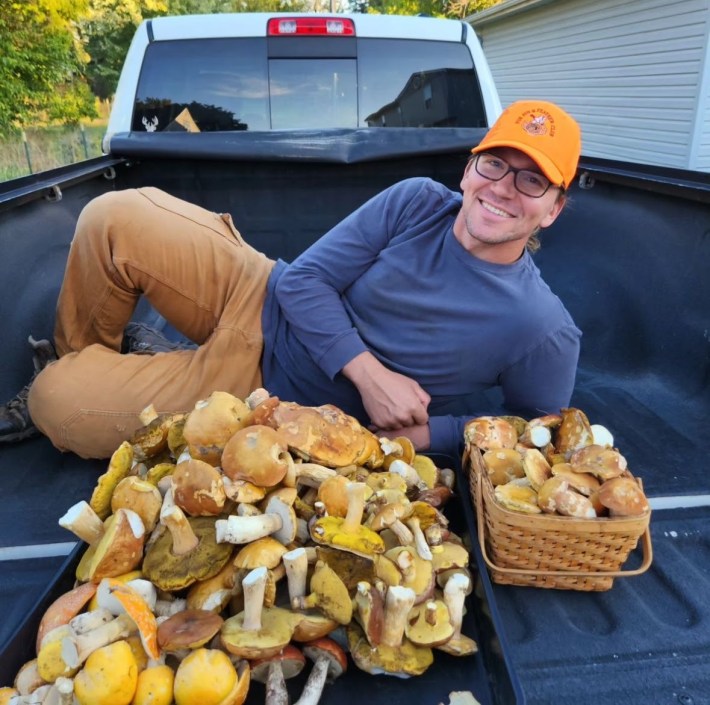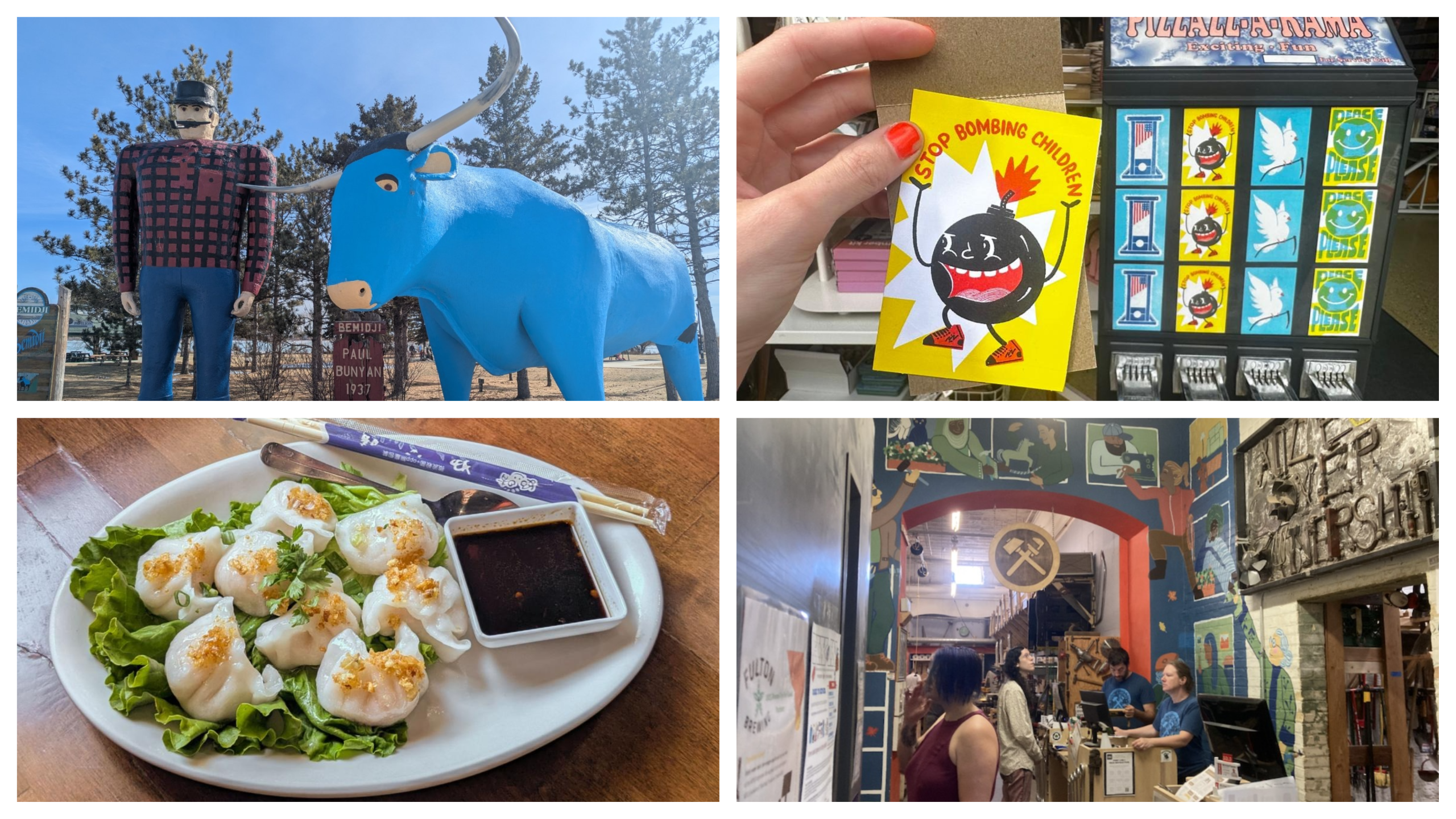Folks who know fish and game know Hank Shaw, the James Beard Award-winning chef, author, and outdoorsman whose five books include Hunt Gather Cook and Duck Duck Goose. And folks who know foraging know Samuel Thayer, the widely revered forager and author who penned The Forager's Harvest and Nature's Garden.
But something those folks might not know? Shaw and Thayer are based in Minnesota and Wisconsin, respectively.
“For both of those people to be in states that are connected with each other… the Midwest [now has] one of the biggest concentrations of foraging talent and knowledge in the whole world,” Alan Bergo, also known as The Forager Chef, tells Racket.
What’s more, thanks to platforms like TikTok and Instagram, these longtime wild food experts are joined by a growing number of naturalists who share their thoughts on everything from foraging to homesteading with followers. Many of them from right here in Minnesota!
While it may sound counterintuitive, social media users can become online John Muirs, evangelizing the power of nature, teaching real-life skills, and racking up clout in the process. Get to know four locals who’ve built big audiences by transporting their followers into the great outdoors.

Linda Black Elk
TikTok: @linda.black.elk | Instagram: @linda.black.elk
In a TikTok from last June, Linda Black Elk crouches in the gardens that surround the REI in Bloomington. “I like finding food and medicine in some unusual places,” she says by way of introduction, before taking viewers on a tour of the edible and medicinal plants in the area: mirabilis nyctaginea, which can be used to treat swelling, and monarda fistulosa, an antimicrobial member of the mint family.
Wherever Black Elk goes, her 73,000 followers get a chance to tag along, whether she’s tracking down tilia americana at a rest area north of the Twin Cities or harvesting biscuitroot in the Black Hills.
She chuckles, thinking about the times she’s pulled out her camera in parking lots and traffic medians. Once, walking along LaSalle Avenue in downtown Minneapolis, she marveled to her husband about the plants growing from the sidewalk. “He said, ‘You should do a video.’ And within 50 feet of the center of LaSalle, I found like 50 edible and medicinal plants,” she recalls.
@linda.black.elk Y’all should’ve seen the looks on peoples faces as my husband and I measured a 50 foot radius around a random spot in the middle of LaSalle Avenue in Minneapolis, Minnesota. But it was worth it! I can’t believe all of the amazing edible and medicinal plants that we found within that tiny area. Our Mother Earth is always resilient, and she always provides. I hope we will all step up and nurture relationships with the plants around us… Even if they are growing out of the cracks in the sidewalk! FoFoodSovereigntynIndigenousFoodSovereigntyoForagingoForagerhChubbyForagereMedicinalPlantsdEdibleWildPlantslPlantMedicineiMinneapolisrbanForaging
♬ original sound - Chubby Forager
This familiarity with nature comes, well, naturally to Black Elk; she’s been foraging as long as she can remember. Her mother was an Indigenous woman from Korea, and both she and her grandmother were lifelong foragers—“mostly for necessity,” she explains.
“I feel like that got passed down to me as a matter of practice,” Black Elk says. “My mom always told me: ‘You never have to pay for food if you know what these things are, and you know how to hunt,’ things like that.”
(There’s a reason her Instagram bio reads, “You want me on your zombie apocalypse team.”)
An ethnobotanist, Black Elk shows viewers how to identify native plants by sight and smell, and shares their uses. She also—and this will make you feel much smarter with each TikTok you watch—gives their scientific titles along with their English and Native names. Comptonia peregrina, for example, is known as gabaa’aagemish in Ojibwe, šupé pȟežúta in Lakota, and in English, sweetfern. It has a distinctive u-shape and unforgettable aroma, and can help with digestive issues. All that info is packed into a single one-minute clip.
Plants are both practical and personal to Black Elk; they’ve always been an important way for her to connect to the land she’s on. “An elder once said to me when I was growing up, ‘You know you’re not home if you don’t know the plants when you walk out the door.’” Learning about the plants around her is a way to feel more at home, and to create a sense of belonging—a feeling she wants to share with others.
One mission of hers is to share that foraging knowledge with young people, and her wonderful son Wawikiya often helps out there.
“There’s an epidemic of loneliness among young people… and I feel like if you walk out your door and you’re surrounded by plant relatives—ones you know very well—then you never feel alone,” she says. “And you always have something to eat, like my mom used to say.”
Maybe you’ll notice, after watching a few of her TikToks, just how many edible and medicinal plants there are all around us. You won’t be alone: “Plant blindness is real,” Black Elk says. “I don’t think people talk about it enough, but it’s a very real thing.”
If you’re interested in foraging, Black Elk says to start slowly building a relationship with plants around you. Stay calm, get to know their names, and take your time—some plants require more care than others, and harvesting has to be done with sustainability in mind. Start simply… maybe with some dandelions, for example.
“Purslane and plantain and dandelion are all delicious and amazingly medicinal, and they grow out of the cracks in your driveway,” she explains. “Because the other thing is, most people aren’t going to mind if you harvest some dandelions out of a public area.”

Katie Krejci
Instagram: @thehomesteadingrd | TikTok: @thehomesteadingrd | Website: thehomesteadingrd.com
Growing up, Katie Krejci had just one dog and a “typical” suburban lifestyle. She really wanted a hamster, but mom said no.
Today dogs, cats, and chickens roam her off-the-grid, 240-acre slice of northern Minnesota wilderness. So many chickens.
“Honestly, chickens are so simple,” she says. “Once you have a coop set up, they basically take care of themselves.” (Honeybees proved much more difficult, she reports.)
Krejci’s path to almost a decade of self-reliance began in 2006, when she bought a small Kansas City house with her husband, Ryan. She fell in love with gardening there—fruit trees, herbs, nothing fancy.
"We knew we always wanted to live in the country,” she says. “We found our first five-acre homestead in 2013 in eastern Minnesota… that's where everything really took off."
@thehomesteadingrd 🦟🪰Bugs and country living definitely go hand-in-hand and the bugs seem exceptionally bad this year! There are SO many products and tips out there, so it can be overwhelming to know where to start. Plus, it’s important to use strategies that won’t impact beneficial insects 🐝 or your own health. These are our personal favorites and what has been working really well on our homestead to keep the deer flies, horse flies, house flies, and mosquito population down. It’s a process, but we’re getting there! 💫 Do you have any other favorite products? Share them with us! Visit my amazon store for links to these products! #countrylife #countryliving #homesteadlife #homesteader #mosquitocontrol
♬ original sound - The Homesteading RD
Krejci, who was working full time as a hospital dietician, has a master’s degree that informs a bedrock of food knowledge, though she became disillusioned by “conventional medicine” focusing more on symptoms, less on holistic healing. So she began teaching herself the basics of homesteading from books to help build a more natural life. Vegetable Gardener's Bible helped expand her gardening; Storey's Guide to Raising Chickens guided the expansion of her flock.
At the time, social media had yet to discover the world of homesteading. Krejci wasn’t even familiar with the term. “I was just calling it growing my own food,” she says. Slowly but surely, the self-described introvert began posting to @thehomesteadingrd about her veggies, baby chicks, and food preparation/preservation. (The “RD” stands for registered dietitian.)
That brand of anybody-can-do-it resourcefulness has attracted a major social media following. More than 329,000 folks follow @thehomesteadingrd via Instagram, and Krejci’s other channels boast large followings as well. She took the “big scary step” of quitting her dietician job a couple months back, making the business of online homesteading her main one.
“I started sharing and it really caught on,” she says. “I just learned more and more about how you can make money as an influencer. I still can't believe it."
Her expanded acreage, which she and Ryan acquired this past summer, has allowed for more clips of foraging and hunting; they recently bagged their first deer, and Krejci says they flipped through a how-to book about field dressing… while in the actual field with the deer.
Scrolling through Krejci’s feed—where you’ll encounter posts like "COMMON GARLIC PLANTING MISTAKES," "HOW TO PIECE OUT A WHOLE CHICKEN," and "THE POOP CHUTE!"—make you feel like, hey, maybe I can also live the homesteader dream. Inspiring outdoorsy daydream magic is enough for most followers, most of whom probably don’t ever make good on that “CHICKEN COOP WINTERIZING” tutorial.
It’s just reassuring to know Krejci’s lifestyle is an option.
"It's a dream come true,” she says, sounding genuinely amazed. “And it wasn't even really a plan... it just happened.”

Alan Bergo
Instagram: @foragerchef | Youtube: Forager Chef | Website: foragerchef.com
“My life is so strange—it’s something I never could have imagined,” says Alan Bergo, known to his legion of followers as the Forager Chef.
Bergo’s first experience with foraged foods was during his time as a sous chef at Heartland, the groundbreaking St. Paul restaurant from chef Lenny Russo and his wife and business partner Mega Hoen. One of the state’s original farm-to-table restaurants, Heartland only worked with ingredients from within a 300-mile radius. And Bergo was responsible for helping to write and rewrite the menu, which was brand-new from day to day.
“It’s like being a Green Beret,” he chuckles. “There’s like, no other restaurant that operates like that, where the chef is not testing all the recipes—it’s us.”
He describes his experience there as opening the door for his creativity, and calls it one of the greatest gifts he’s ever been given.
Heartland also introduced Bergo to all the best wild mushrooms there are. But it wasn’t until one day, when he was playing disc golf and saw a cluster of chicken of the woods, that it clicked: Mushrooms weren’t an unattainable, five-star-exclusive thing. Finding them was just a matter of timing, and weather, and being aware. Even a broke chef playing a free round of disc golf could do it.
“I was living in my friend’s basement at the time, ‘cause you don’t make any money cooking, and I would pay for my rent, partially, by, like, cooking him breakfast. And I would make things that I had picked off the ground in the woods,” Bergo recalls. That friend suggested he start a website, and well, “ten and a half years later, after writing something for my email list every single week, it became its own thing,” he says. “Every day, I have to wake up and pinch myself, because it’s now all I do.”
A quick rundown of a few things that have happened since: Bergo authored The Forager Chef’s Book of Flora: Recipes and Techniques for Edible Plants from Garden, Field, and Forest (Chelsea Green Publishing Company, 288 pages). He was the 2022 James Beard James Foundation Award Winner for instructional visual media for his video series Field Forest Feast. And he appeared on the Hulu series Chefs vs. Wild, in which chefs are dropped into the wilderness and tasked with finding foods and preparing a world-class meal with them.
“The wild food world is this huge Venn diagram of hunting, homesteading, permaculture and perennial crops, mushrooms, plants, survivalists, the vegetarian and plant-based community—it is wide, and broad, and deep,” Bergo explains. But, he chuckles, for the most part, “you have plant people, and you have mushroom people.”
Bergo’s wild food interest was piqued by mushrooms, and then he expanded into other plants. He straddles those worlds, and those dual interests make him a unique fixture in the foraging community. “Foraging is a learned skill,” he explains, “and I’m a habitual obsessive learner. I saw that this was something I could never master.” Years later, he’s delighted to see that interest expanding, and fast. “I can see the hard data from the views on my site, and every year, it’s just like: buckle up. This is getting real.”
As for what’s behind that growing interest, he credits everything from HBO’s The Last of Us (cordyceps was a big search term there for a while) to Alexis Nikole Nelson (@blackforager), who’s a close friend and, if you’re not familiar, an absolute must-follow on TikTok. And if you find your interest growing—well, he recommends field guides, and online resources like TikTok and YouTube, and plant identifying apps (though he adds the caveat that you need to be careful… don’t eat something just because iNaturalist said you could).
Once you’ve eaten something you foraged a few times, Bergo insists it’ll feel as natural as buying a banana at the grocery store—and in reality, it’s much more natural, isn’t it? “We undervalue our instincts and have a huge capacity for pattern recognition,” he says. “We’ve been foragers for much longer than we have been sedentary.”
And it’s simply fun to do: you’re learning, you’re getting outside, you’re turning a hike or a walk through your neighborhood into a treasure hunt for delicious, and sometimes even valuable, things.
“I have described it before as the final frontier of the farm-to-table movement,” he says. “Once you turn the switch on, you can never turn it off. It’s like awakening this ancient instinct.”

Tim Clemens
Instagram: @mnforager | TikTok: @mnforager | Website: ironwoodforaging.com
If there’s a Super Bowl for the types of folks we’re profiling in this article, it might just be History’s Alone, the survival contest that features actual wilderness experts attempting to outlast one another in Earth’s most unforgiving locations.
Tim Clemens was invited to participate ahead of the first season in 2015. He turned the TV show down because of the time commitment required to fight (alone, while starving) for that $500,000 prize.
"The producers were like, 'You have to sign the contract to be gone for up to a year,’” he remembers. “Turns out, the first season lasted a month or something like that. These days I’m definitely sitting on the couch with popcorn trash-talking, but I think I'd maybe last… three weeks."
Clemens was a certified city kid growing up in south Minneapolis. Starving for TV audiences in remote British Columbia didn’t cross his mind, though he did go “kinda feral” with his identical twin brother. Together, the Clemens brothers would raid community gardens, pluck from cherry trees, and gobble alleyway raspberry bushes. They weren’t familiar with the concept of urban foraging—”We were just hungry!” he says.
In the early 2010s, after graduating from the University of Minnesota with an anthropology degree, Clemens started getting serious about foraging. His monthly food bill was mostly erased by 2015, when he’d eat waste food from his night job at Butcher & the Boar and score fruits and greens from Powderhorn Park. Clemens developed a five-year plan to make a career out of foraging, and by the time the pandemic closed B&B in 2020, he was prepared to make Ironwood Foraging his main gig.
Since launching Ironwood in ’17, Clemens has conducted workshops and held private sessions that have educated over 3,000 people on how to find foods that are right there for the taking. He considers foraging in places like state parks to be “easy mode,” and instead hopes to show students that “city landscapes of scarcity are actually landscapes of abundance.” He points to acorns (“great for pancakes”), wild plums (“taste like sunshine”), and burdock (“the source of the original recipe for root beer"). And of course there’s “potentially the best berry out there,” serviceberries, which can be found growing all over gas station parking lots, he notes.
Clemens has built a strong online presence, with over 47,000 followers at his @mnforager Instagram account. That sort of free online advertising has helped make Ironwood his full-time job, and the community of like-minded folks he’s discovered online has fostered something far less common than serviceberries: a healthy relationship with social media.
"I initially ran to nature to get away from people, but foraging and educating has brought me back to people,” he says, adding: "Also turns out you can shitpost hyper-niche memes; this whole community can feel like one big inside joke."
Clemens gets audibly excited when discussing the “byzantine” patchwork of foraging regulations that exist throughout the state. While rattling off terms like food sovereignty and tree rights, he reiterates his belief that well-intentioned restrictions to preserve nature “like a museum” actually promote food waste and disincentivize people from exploring.
But Clemens doesn’t dwell too long in the realm of foraging politics. The former president of the Minnesota Mycological Society is too busy spreading the gospel of discovering porcinis, pears, and Eastern skunk cabbages, all of which are just laying around in plain sight.
“I can't express enough the healing nature of going into nature, and really paying attention to what you see,” he says. "I'll do this for the rest of my life. If it goes bigger than this with a book or a TV show, that's great. But if it only ever means me teaching a handful of people... I just want to spread this message."







